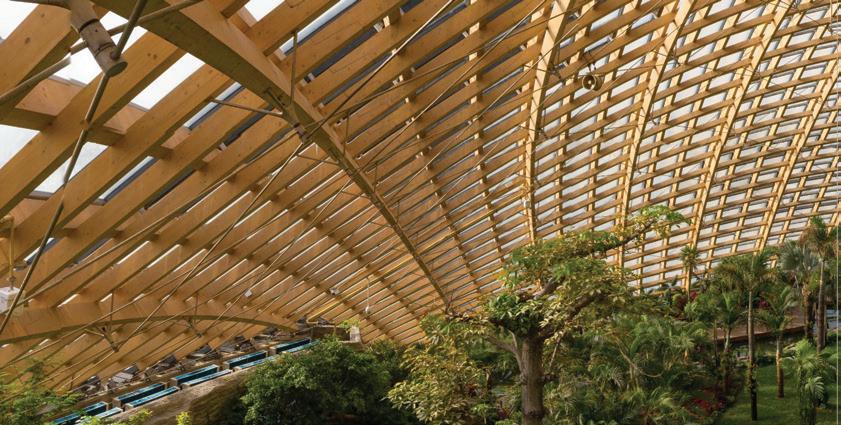
6 minute read
Case Study: Taiyuan Botanical Garden
Lucas Epp, P.E., P.Eng.
The Taiyuan Botanical Garden, located in the capital of China’s Shanxi province, features an artificial landscape that combines nature and architecture in a unique destination for local and international visitors. The Greenhouse is the centerpiece, featuring three biodomes that enclose flora from tropical, desert and aquatic biomes. The dome structures range 140–300 ft. in diameter and 40–100 ft. in height. The largest of the three domes is believed to be the longest clear-span timber gridshell (non-triangulated) worldwide. It is also likely the largest timber gridshell to be covered entirely in doubly curved glass, adding significant challenges to the structural design, which is in a region with significant seismic hazard. All three parabolic gridshells comprise light doubly curved glulam beams, arranged in two or three crossing layers.
Advertisement
The project pushes the boundaries of structural engineering, materiality and construction technique in a country that has little experience using timber for long-span applications. The use of a unique, optimized geodesic grid allowed minimization of doubly curved glulam, and enabled a manufacturing pace which could keep up with an intense Chinese construction schedule.
When viewed from above, the timber structures resemble seashells, with the primary members tightly spaced on one side and fanned out across the surface of the domes, driven by a desire to optimize solar gains by creating a gradient in skin transparency. This complex arrangement means that every one of the 2,400 glulam members is unique, many of which are doubly curved. Wood facilitated this “seashell” look in a more natural way than other structural materials could.
Computational design methods inside Rhino and Grasshopper were used extensively from concept design through to fabrication geometry and automatic generation of CNC machine files. This structurally optimized geometry was developed while looking at all constraints, including shipping/containerization, fabrication and pre-assembly, with kit-of-parts erection and sequencing drawings for site crews.
The unique seashell aesthetic on these domes required a two-way grid. This requirement created the project’s single biggest challenge: achieving an efficient timber gridshell with elements which were moment-fixed to each
other, but with completely hidden connections. The connections used between the layers of the shell developed composite action between the top and bottom parallel layers, as well as rotational stiffness between the orthogonal layers. This rotational stiffness was critical to prevent in-plane shear buckling failure modes. Connection concepts using fully threaded screws were tested to failure at full scale both in-house at StuctureCraft and at Tongji University to establish strength and stiffness of the connections. These values were then input back into analysis models to allow accurate prediction of buckling and seismic performance.
The orientation of the beams was optimized to limit the amount of milling that was required, while still achieving the doubly curved shell geometry envisioned by the project architects. The curved timber beams, produced by two different European glulam manufacturers, were then packed together in shipping containers using an algorithm to organize in the order that they would be needed for site assembly in China.
The beam crossing elements were notched to fit tightly together, and pre-drill hole locations were mapped in Grasshopper, then drilled by CNC so workers on site could install approximately 60,000 screws in the required locations. At the junction with the ground, the timber beams connect to steel assemblies that are welded to embed plates cast into the concrete. All beams approach the ground at different angles, so each steel component is unique but generated from a simple set of parametric rules. The prefabricated panels ranged from 20–30 ft. wide and 30–40 ft. long. These were preassembled adjacent to the domes and craned into place onto temporary scaffolding, whose geometry was prescribed in the erection drawings.
The delivery of the design and manufacture of this structure in less than 1.5 years was made possible only by combining a unique, vertically integrated team of structural engineers. Use of extensive computational geometry and analysis tools, along with a bespoke software system to enable straight-to-fabrication from Rhino, was central to enable the digital fabrication and construction processes used throughout this project. The result is a world-class attraction, created through the efficient cooperation of team members on three continents.
ARCHITECT Delugan Meissl Associated Architects
Vienna, Austria
STRUCTURAL ENGINEER + TIMBER CONSTRUCTION StructureCraft
Vancouver, BC
LOCAL DESIGN INSTITUTE Institute of Shanghai Architectural Design & Research
Shanghai, China
FACADE/INITIAL STRUCTURAL CONCEPT Bollinger + Grohmann
Vienna, Austria
PHOTOGRAPHY CreatAR, Shanghai; Light Chaser, Taiyuan
For the expanded case study, including an image gallery, visit WoodDesignandBuilding.com.

JURORS

Anne Schopf
Partner Mahlum
mahlum.com
John Newman

Director Snøhetta
snohetta.com
David Edmunds

Partner GEC Architecture
gecarchitecture.com
2020 Wood Design & Building Award Winners
Much like 2020, this has been a year unlike any other, and as most events became virtual due to the ongoing pandemic, the annual awards were postponed and held in early spring via video conference. Luckily, the awards entry platform has been cloud-based for several years, so the transition was relatively seamless. Although the staff and jurors missed the opportunity to connect in person, the daylong session was just as engaging and animated as ever.
Each year a three-person jury independently reviews the submissions, and on the final day of judging, the entries with the highest scores are discussed and reviewed by the group. This year we welcomed Anne Schopf, partner at Mahlum; John Newman, director and senior architect at Snøhetta; and David Edmunds, partner at GEC Architecture. Each jury has a unique perspective on architecture, and this year, most decisions were resolved without considerable debate. Those projects chosen as the winners were selected definitively, with unanimous enthusiasm.
The selection of the Honor winners is always fascinating because what might strike someone as a grand design is not necessarily what catches the attention of the jury. Creativity and unique applications, along with balance and elegance, consistently rise to the top – as demonstrated by the three projects chosen for 2020. A small library in China nestled against a natural rock wall, an outdoor recreation rink in Quebec and a multipurpose barn in Arkansas might not sound like award-winning ideas, but all three jurors were struck by the beautiful execution and striking impact of these structures. As Schopf commented, “Simple and elegant is really, really hard to do.” Each project shows the versatility of working with wood, and perhaps not coincidentally, all three Honor winners create environments that encourage a communal experience.
This year, we also expanded the magazine awards coverage to include more detail about the Merit, Citation and sponsored awards, because in many cases, these are structures that narrowly missed the top category. Seven countries are represented, with 16 winners from Canada and 10 from the U.S. Among the winners, Perkins&Will, Marlon Blackwell Architects, LUO Studio, Brook McIlroy, 1x1 architecture and Michael Green Architecture each claimed two awards.
In partnership with the Canadian Wood Council, we would like to thank everyone who participated in the 2020 Wood Design & Building Awards program, with special thanks to our three jurors and the program s sponsors. Congratulations to the winners!






